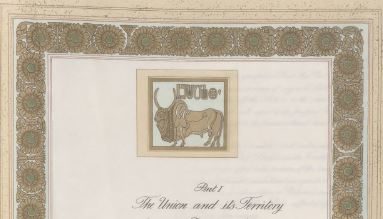In this special feature on Constitution Day, we bring you a rare treat: 10 things we bet you didn’t know, and between each leaf is the art from the original Constitution of India.
Let’s start with the Preamble:

The English and Hindi editions of the Constitution were hand calligraphed.

Each page was illustrated with art by artists from Shanti Niketan.

You can download the entire Constitution of India from here:
https://tile.loc.gov/storage-services/service/ll/llscd/57026883/57026883.pdf

On December 9th, 1946, Shri Sachidananda Sinha, the first Chairperson of the Constituent Assembly, ended his inaugural address with these lines of poetry by Allama Iqbal:
Yunan-o-Misr-o-Roma sabmit gaye jahan se,
Baqi abhi talak hai nam-o-nishan hamara.
Kuch bat hai ke hasti mit-ti nahin hamari,
Sadion raha hai dushman daur-e-zaman hamara.
Greece, Egypt, Romans have all perished, but we are still around. There must be something special in us, for we survive though we have been opposed for centuries.

The Constituent Assembly also acted as the de facto legislature until the Lok Sabha was instituted in 1950. The Constituent Assembly adopted the national flag, national anthem, and national song of India!

The expenses of the Constitution Assembly from December 9th, 1946, to 22nd November 1950, came to Rs. 63,96,729/-

On the final day of the debates of the Constituent Assembly – Jan 24th, 1950, all the members of the Assembly were congratulating the Chairperson of the Assembly, Shri Rajendra Prasad, on being elected the first President of India. After a while, a visibly embarrassed Shri Rajendra Prasad said:
For once after three years, I hope the House will permit me to stop further discussion.

The last session of the Constituent Assembly was held on January 24th, 1950, and it was disbanded on January 25th, 1950.

ALL the debates of the Constituent Assembly can be read online!

On the first day, December 9th, 1946, the highest attendance recorded was by the members from Madras Presidency – 43 members. This group included stalwarts such as C Rajagopalachari. The second largest group was from the United Provinces – 42 members.














